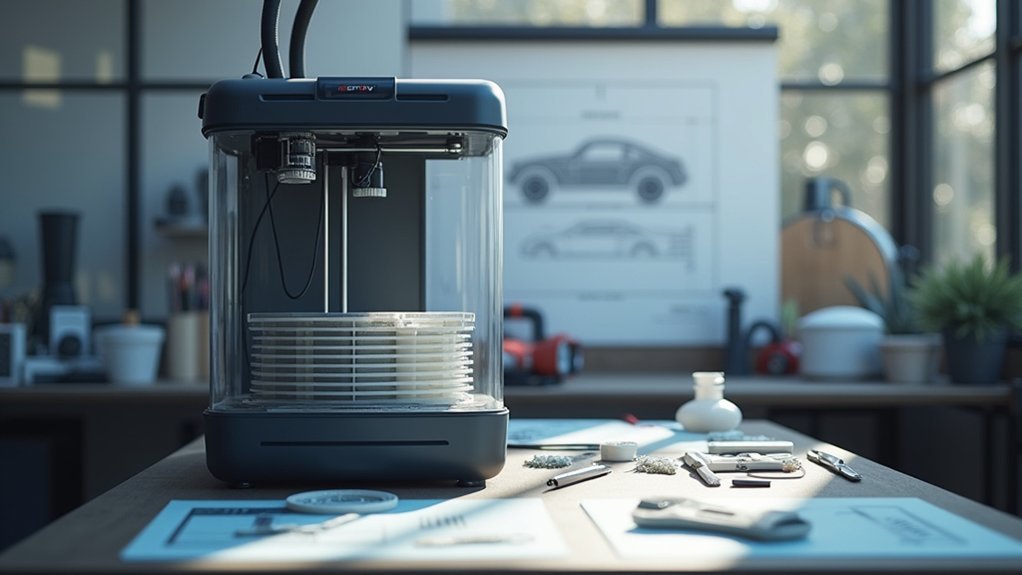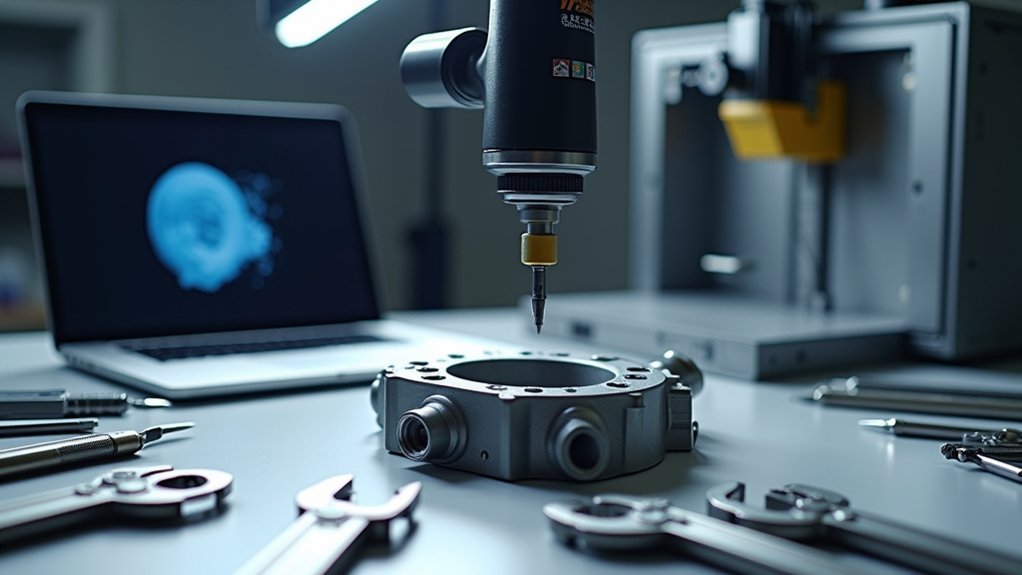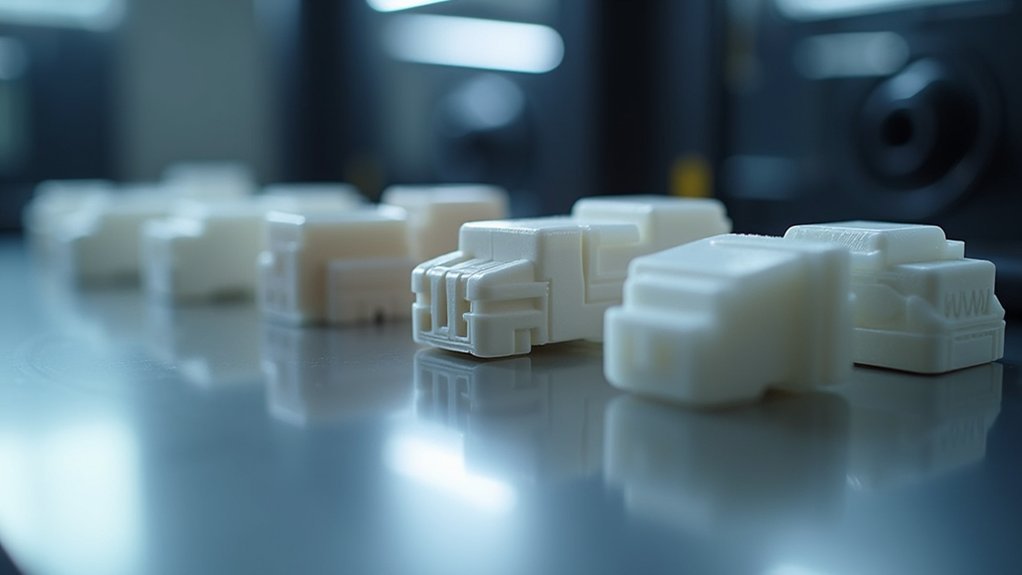To 3D print automotive electrical housings, you’ll need temperature-resistant materials like PETG or nylon that can handle up to 80°C and vibrations. Design your housing with 0.5mm clearance around components and 2mm extra for connectors, while incorporating drainage features and proper sealing mechanisms. Use FDM printing with 0.1-0.2mm layer heights and 20-50% infill density. Guarantee compliance with ISO 16750 safety standards through thorough testing including thermal cycling and insulation resistance checks. Master these fundamentals to create reliable automotive-grade housings.
Understanding Automotive Electrical Housing Requirements

When you’re designing automotive electrical housings for 3D printing, you’ll need to account for the extreme conditions these components face daily. Your housings must withstand moisture exposure, temperature fluctuations, and constant vibrations while maintaining electrical reliability.
Automotive electrical housings demand robust 3D printing solutions that endure moisture, heat cycles, and vibrations without compromising electrical performance.
Material properties become essential when selecting filaments like PETG or nylon, which offer heat resistance for engine compartment applications. These materials maintain structural integrity under elevated temperatures that would compromise standard plastics.
Your design considerations should prioritize proper sealing mechanisms and insulation to prevent moisture ingress and electrical shorts. You’ll need precise gasket channels and secure connector accommodations.
Printing processes must align with ISO 16750 compliance requirements for automotive environmental testing. This guarantees your 3D-printed housings meet industry safety standards while providing secure fits for terminals and circuit boards.
Essential Tools and Materials for Automotive Housing Projects
Five essential components form the foundation of any successful automotive electrical housing project. You’ll need precise measurement tools and reliable printing technology to achieve professional results.
- Measurement Tools: Vernier calipers are vital for capturing exact dimensions of connectors and housings, ensuring proper fit and functionality in automotive applications.
- 3D Printer: A reliable printer capable of handling various materials like PETG or nylon is essential for creating durable housings that withstand environmental stressors.
- Design Software: CAD software enables detailed modeling and modifications based on specific vehicle requirements.
- Material Selection: PETG offers an ideal balance of strength and temperature resistance for automotive applications experiencing heat.
You’ll also need basic post-processing tools like sandpaper or precision knives to refine printed parts for smooth finishes.
Measuring and Reverse Engineering Original Components

You’ll need to establish a reference datum point on your original component before taking any measurements to guarantee consistency throughout the reverse engineering process.
Use vernier calipers to capture precise outer dimensions, connector spacing, and critical angles while systematically documenting each measurement for your CAD design.
Your component analysis should identify mounting features, retainer blocks, and connection points that must be replicated in the 3D printed housing.
Precision Measurement Techniques
Before you can create an accurate 3D model, you’ll need to meticulously measure every dimension of the original electrical housing using precision tools.
These precision measurement techniques guarantee dimensional accuracy throughout your design process.
Use vernier calipers to measure all critical dimensions with 0.01 mm precision. Your measurements should include:
- Maximum outer dimensions and internal features like holes and grooves
- Specific distances between angles, flat edges, and connector points
- Retainer block specifications for proper spade connector fit
- Internal cavity depths and wall thicknesses
Establish a consistent datum reference point on the original component to baseline all measurements.
Document both external housing dimensions and internal connector geometry meticulously.
This thorough measurement approach creates the foundation for an accurate 3D model that’ll replicate the original housing’s functionality perfectly.
Component Analysis Methods
With your measurements complete, systematic component analysis transforms those precise data points into actionable design parameters.
You’ll build your enclosure design by establishing a datum point on the original housing as your reference baseline. This guarantees consistency throughout your reverse engineering process.
Create an initial cuboid model using your vernier caliper measurements, then methodically document distances to angles, flat edges, and internal features.
Your component analysis methods must account for retainer blocks and connector holes sized precisely for spade connectors. Don’t overlook electrical compatibility requirements.
Leverage reverse engineering software to develop a thorough 3D model that captures critical tolerances. This systematic approach guarantees your final design replicates the original housing’s functionality while meeting 3D printing requirements for automotive applications.
CAD Design Considerations for Vehicle Electrical Housings
When you’re designing CAD models for automotive electrical housings, you’ll need to focus on two critical aspects that determine your project’s success.
First, you must establish proper component clearance requirements by incorporating the right tolerances and spacing around connectors, wires, and internal parts.
Second, you’ll want to take into account material selection factors that affect both the printing process and the housing’s long-term performance in automotive environments.
Component Clearance Requirements
Since automotive electrical components must fit precisely within their housings while maintaining reliable connections, you’ll need to establish proper clearance requirements during your CAD design phase. These specifications guarantee your printed enclosure accommodates manufacturing tolerances while preventing interference issues.
When defining component clearance requirements, consider these essential parameters:
- Internal Components: Maintain minimum 0.5 mm clearance around all components to account for tolerances and mechanical properties of your printing material.
- Port Openings: Add 2 mm extra clearance beyond connector dimensions for secure plug insertion without obstruction.
- Connector Measurements: Accurately measure maximum outer dimensions of all connectors before finalizing housing geometry.
- Retainer Integration: Design dedicated retainer blocks for spade connectors to guarantee stable electrical connections.
Regular testing and design iteration will help you optimize clearances for reliable functionality.
Material Selection Factors
After establishing proper clearances for your components, you’ll need to select the ideal printing material that can withstand automotive environments while maintaining structural integrity.
Material selection factors include temperature resistance, with PETG maintaining stability up to 80℃ for heat-sensitive applications. You must consider current capacity requirements to guarantee your chosen filament handles electrical loads without degradation.
For housings requiring repeated flexing, nylon offers superior flexibility and durability due to its high tensile strength and elasticity.
Moisture and chemical resistance are critical—HIPS and ASA provide excellent chemical resistance while minimizing warping.
Your choice of printing technologies also impacts material selection: FDM works well for cost-effective prototyping, while SLA delivers high-detail finishes for production parts.
Material Selection for Automotive Environmental Conditions

Although automotive electrical housings face harsh environmental challenges, choosing the right 3D printing material can guarantee your components withstand extreme conditions throughout their service life.
Your material selection must address multiple environmental factors that’ll impact performance and safety.
Consider these critical environmental requirements:
- Temperature resistance – Select high-temperature resistant plastics like PETG or nylon that handle up to 80°C in engine compartments.
- Impact durability – Choose materials with excellent flexibility to absorb vibrations and mechanical shocks.
- UV protection – Incorporate UV-resistant additives or coatings for components exposed to direct sunlight.
- Moisture resistance – Prioritize materials like ASA that resist humidity and prevent long-term degradation.
You’ll also need to verify electrical insulation properties to prevent dangerous electrical bridging in your automotive applications.
3D Printing Technologies Best Suited for Automotive Applications
Five distinct 3D printing technologies offer unique advantages for manufacturing automotive electrical housings, each tailored to specific performance requirements and production goals.
| Technology | Best Application | Key Advantage |
|---|---|---|
| FDM | General housings | Cost-effective versatility |
| SLA | Detailed components | High precision finish |
| SLS | High-temp environments | Robust durability |
| DLP | Rapid prototyping | Fast production speed |
| Material Jetting | Multi-component parts | Mixed material properties |
You’ll find FDM most practical for everyday automotive applications due to its compatibility with ABS and PETG materials. When you need precise dimensions for electrical housings, SLA delivers smooth surface finishes. For high-temperature environments, SLS creates durable printed parts using powdered materials. DLP accelerates your prototyping timeline for connectors and intricate designs. Material Jetting enables prototyping and end-use parts combining flexible and rigid components simultaneously.
Print Settings and Parameters for Optimal Housing Performance
When you’re configuring your 3D printer for automotive electrical housings, precise parameter control determines whether your parts meet stringent performance standards or fail under real-world conditions.
Your printing parameters directly impact uniform wall thickness and snap fit tolerances. Here’s what you need to improve:
- Layer height: Set between 0.1-0.2 mm for detailed features while maintaining reasonable print speeds.
- Print speed: Use 30-60 mm/s to enhance layer adhesion and minimize defects in intricate designs.
- Infill density: Adjust to 20-50% for sturdy structure without excessive material waste.
- Nozzle diameter: Choose 0.4 mm for ideal balance between detail resolution and print efficiency.
You’ll also need proper bed adhesion with heated temperatures of 60-70°C.
Consider applying adhesive to prevent warping that compromises dimensional accuracy.
Post-Processing Techniques for Automotive-Grade Finish
After printing your automotive electrical housings, you’ll need to remove supports carefully to avoid damaging critical mounting points or connector interfaces.
You can achieve professional surface quality through sanding, vapor smoothing, or chemical treatments that eliminate layer lines and create the smooth finish required for automotive applications.
Finally, you’ll want to apply heat resistance treatments like annealing or specialized coatings to guarantee your housings can withstand the demanding thermal conditions found in vehicle engine bays.
Support Removal Methods
Since automotive electrical housings require precise tolerances and professional finishes, you’ll need to master several support removal techniques to achieve production-quality results.
Your choice of support structures directly impacts both removal ease and final surface finish quality.
Consider these effective post-processing methods:
- Manual removal – Use pliers or cutters for precision work in tight areas, minimizing damage risk to delicate housing features.
- Chemical dissolution – Apply heated isopropyl alcohol baths for SLA prints to dissolve supports without manual intervention.
- Mechanical finishing – Sand and file rough edges or support remnants to enhance aesthetic and functional quality.
- Ultrasonic cleaning – Utilize high-frequency sound waves in cleaning solutions to dislodge supports from intricate designs without physical contact.
Select support materials compatible with your printing technology for ideal results.
Surface Smoothing Techniques
Beyond removing supports, achieving automotive-grade surface quality requires dedicated smoothing techniques that eliminate layer lines and create professional finishes.
You can start with progressive sanding using finer grits to prepare surfaces for additional treatments. Chemical smoothing agents like acetone work effectively on ABS prints, dissolving surface imperfections while enhancing aesthetic quality.
Vapor smoothing creates glossy finishes by using solvent vapor to melt the outer layer. For minor imperfections, gently apply a heat gun to soften the surface and smooth irregularities.
Surface smoothing techniques prepare your parts for painting with automotive-grade primers and paints. Always guarantee compatibility between your chosen 3D printing material and finishing products.
These methods transform rough prints into professional-quality electrical housings suitable for automotive applications.
Heat Resistance Treatment
While surface quality matters for aesthetics, thermal performance determines whether your 3D printed electrical housings will survive automotive environments. Heat resistance becomes critical when components face temperatures up to 80°C or higher.
Several post-processing techniques can greatly improve your housing’s thermal capabilities:
- Annealing – Reduces internal stresses in PETG parts, enhancing dimensional stability at elevated temperatures.
- High-temperature resistant paints – Apply specialized coatings for additional thermal protection and improved aesthetics.
- UV post-curing – Expose SLA printed parts to UV light, considerably boosting thermal properties and material strength.
- Material selection – Choose heat-resistant filaments like ASA or Nylon to minimize post-processing requirements.
These treatments guarantee your electrical housings maintain structural integrity throughout their automotive service life.
Testing and Validation of Printed Electrical Housings
When you’ve finished printing your automotive electrical housing, thorough testing becomes essential to confirm it’ll perform reliably in demanding vehicle environments. Your validation process should start with checking the fit of connectors and components, verifying adherence to specific tolerances.
| Testing Type | SLA/SLS Tolerance | FDM Tolerance |
|---|---|---|
| Fitment Check | ±0.4 mm | ±1.5-2.0 mm |
| Connector Alignment | ±0.4 mm | ±1.5-2.0 mm |
You’ll need to conduct insulation resistance tests to prevent electrical bridging and protect sensitive components from short circuits. Thermal cycling testing evaluates material performance under varying temperatures typical in automotive environments. Don’t skip mechanical testing—perform tensile and impact resistance assessments to confirm your housing withstands vibrations and shocks. Finally, run environmental exposure tests including UV resistance and moisture absorption evaluations to determine real-world durability.
Assembly Methods and Fastening Solutions
After validating your printed housing’s performance, you’ll need to select appropriate assembly methods that balance accessibility with structural integrity.
Your choice of fastening solution directly impacts both manufacturing efficiency and long-term reliability.
Consider these proven assembly methods for automotive electrical housings:
- Snap-Fit Design – Creates secure connections without additional hardware, enabling quick assembly and reducing part count
- Interlocking joints – Provides robust structural integrity that protects sensitive electronics from vibration and movement
- Threaded fasteners – Offers reliable repeated access for maintenance while ensuring dependable connections over time
- Living hinges – Facilitates easy opening and closing while maintaining compact, lightweight designs
Each method serves specific requirements, so evaluate your housing’s accessibility needs, environmental conditions, and maintenance requirements when selecting the best fastening approach.
Troubleshooting Common Automotive Housing Design Issues
Even with careful planning and proper assembly methods, automotive housing designs can encounter specific challenges that compromise functionality and durability.
During the printing process, you’ll often face dimensional inaccuracies that prevent proper connector fitment. Maintain that ±0.25mm tolerance by calibrating your printer and accounting for material shrinkage.
Common 3D printing issues like layer adhesion problems occur when using inappropriate materials—switch to PETG instead of PLA for better temperature resistance.
You’ll also encounter moisture-related failures when designs lack proper drainage features. Add ventilation slots or weep holes to prevent water accumulation.
Pin interference problems arise when internal components don’t align correctly, so verify connector orientations before printing final versions.
Frequently Asked Questions
Can You 3D Print Enclosures?
You can 3D print enclosures using materials like PLA, ABS, and PETG. You’ll customize dimensions, add cable management features, and prototype quickly. You’ll need 2mm wall thickness and proper component clearance for functionality.
Can You 3D Print Electrical Components?
You can 3D print non-conductive electrical components like housings, brackets, and connectors using durable materials. However, you can’t print actual conductive parts – those require traditional manufacturing methods for proper electrical functionality.
Is Anything Illegal to 3D Print?
You can’t legally print firearms, copyrighted designs, counterfeit branded products, or lock-picking tools. Laws vary by location, so you’ll need to check your local regulations before printing anything potentially restricted.
Can You 3D Print Your Own Circuit Board?
You can’t fully 3D print functional circuit boards with active components, but you can create substrates, housings, and simple traces using conductive filaments for basic electronic pathways and prototyping purposes.





Leave a Reply